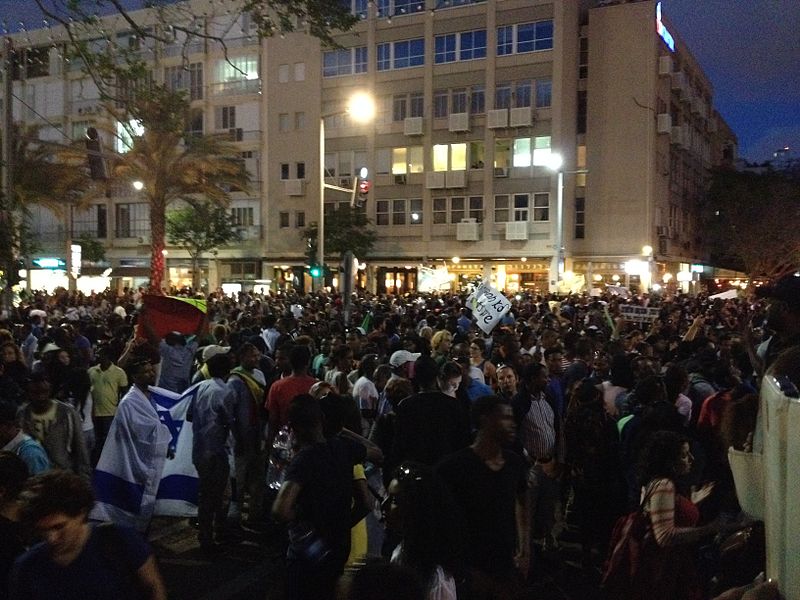A line of policemen armed with shields and stun grenades position themselves across a mob of angry protesters. The protesters wield signs reading “Stop police brutality” and “Black is not a crime.” Their hearts are filled with anger, frustration, and questions without answers. Their color, a constant reminder of their unjust struggle, blends with the color of the sky in the spirit of solidarity. A group of protesters begins to throw rocks at police officers, and a wave of violence emerges. Police throw stun grenades and tear gas in an attempt to control the madness. The night ends in trips to the hospital, arrests, media coverage of the violent riots incited by this notoriously rowdy community, and the country is left in shock and speechlessness.
This, unfortunately, is not a scene from Ferguson or Baltimore from this past year. Nor is it describing America in the 1960s. This is the night of May 3, 2015 from Tel Aviv. The participants are not African-Americans, nor are they Sudanese and Eritrean refugees in Israel. They are Ethiopian Jews who immigrated to Israel or were born in their Jewish homeland sometime between 1984 and the present. On April 27, 2015, a video surfaced online showing a soldier being attacked and brutally beaten by two Yasam (Israeli Police Special Patrol Unit) officers. This video ultimately gave rise to the protests-turned-riots in Tel Aviv about a week later.
That video sparked questions that many young Ethiopians have struggled with throughout their lives. Why are we always the ones to be singled out? Why are we always the first suspects? Why is this state so averted to our skin color? These questions, although uncomfortable to mere passerby, really describe the racial injustice this group of people must endure to live in their own homeland. Ethiopians in Israel face many obstacles to proper assimilation; aside from obvious difference in appearance, the language barrier, adaptation to modern technological advances such as electricity, traditional clothing, and differing cuisines made it difficult for this community to blend in and become a part of the already diverse Israeli society.
During my gap year between high school and college, I lived in Israel in a neighborhood heavily populated by Ethiopian Jewish immigrants and spent my time volunteering in their schools and after-school programs, and hanging out with them in the neighborhood. My first walk into their neighborhood was a bit of a culture shock: children spoke Hebrew and wore their respective school uniforms on a street labeled by a sign written in Hebrew. The strong smell of injera, a traditional Ethiopian sourdough flatbread, filled my nose. Women dressed in traditional white outfits sat on the bench gossiping in Amharic. Older men sat on a nearby bench arguing about religion, each of them dressed in similar traditional white garments and a walking stick in hand. Nobody above the age of 30 spoke Hebrew.
The children growing up on this street are brought up on contradictions. At home, they try to explain to their parent or parents in Amharic what their teacher, music instructor or youth group counselor said to them in Hebrew that day. The city in which they live tries to erect many programs geared toward development and integration of their communities, but in the reality, they face discrimination. In fact, the black presence in Israeli media has been quite sparse and if anything, somewhat negative until recent years.
These struggles may sound similar to any wave of immigration: from the Moroccan Jews in the 1950s to the aliyah from the USSR beginning in the 1990s. However, this group in particular has arguably encountered more racism and injustice since their arrival in the Promised Land: from the questioning of their religion to their unfortunate living circumstances to other Israeli citizens’ attempts to exclude them from nursery schools and apartment complexes. Is this a rite of passage for all cultures who take part in mass migration to Israel or has this particular absorption process become the most difficult and drawn out? After all, Israel, with all the aliyot and all the immigrants it has absorbed, should be completely proficient at the absorption and integration process by now. Could we, as Jews who have faced so much racism and injustice in the past, be one of the greatest perpetrators of discrimination by skin color? Is there something inherently wrong with this group of people?
There have been national and city welfare programs to further integration of Ethiopian Jews into Israeli society; however, these programs suggest an inorganic intention and sometimes only further separate Ethiopians from the rest of society and highlight the community’s weaknesses. During my gap year, at some points I found there to be an expectation of help in this community. This incites the “don’t give the man a fish” argument and perhaps may contribute to the cycle of poverty and discrimination. Another possible factor in the perpetuation of this cycle is the Ethiopian vacuum in Israeli media. Instead, Ethiopian Israelis look to African-Americans in the United States — who have also faced an unending cycle of poverty and discrimination — for inspiration. Only in recent years have Ethiopians had a chance to steal some time in the spotlight from the usual Beyonce, Kanye, and Kobe. Singers like Ester Rada and Hagit Yaso, and reality stars like Tahounia Rubel, have given the youth of this community role models in the media.
The very essence of the State of Israel is that the country is a melting pot of nationalities, cultures, and traditions. People from all walks of life can live in Israel, their Jewish homeland, and should be able to feel comfortable doing so. The high tolerance Israel has set for intolerance is shocking and unacceptable. The Jews living in Israel today are not perfect, but I challenge them to show some empathy and acceptance, and remember their ancestors who faced similar struggles nearly 30 or 50 or 80 years ago.

